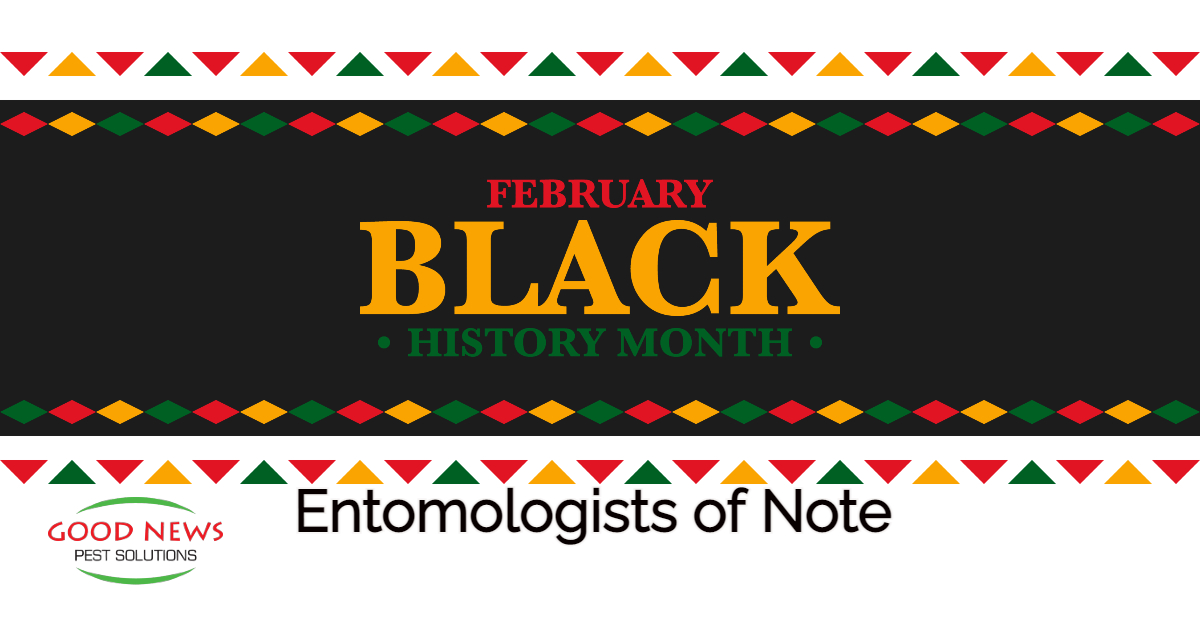
Celebrating Black History Month - Entomologists of Note
Here at Good News Pest Solutions, we spend a lot of time dealing with, talking about, and studying the various bugs we encounter. But as highly trained and capable our Inspectors, Specialists and Associates are, we owe a huge debt of gratitude to the many entomologists who came before us. Scientists who dedicated their lives – sometimes in the face of strong opposition – to explore and make sense of insect life and how it connects with our own - to discover their place and purpose within God’s vast creation.
So as we enter Black History Month, we thought we’d highlight some of the most groundbreaking entomologists who shaped our understanding of the insect world – some of whom you may have never heard of before.
Buzzing With Questions
When Dr. Charles Henry Taylor died in 1923 a single word was placed on his tombstone along with his name and dates: Scientist. What seems like a simple epitaph is actually a sign of so much more. Charles Taylor was one of the last true renaissance men in America – he was a leading zoologist, comparative psychologist, and leading entomologist.
Not content to just study one thing, he was known for combining disciplines – studying the behavior and psychology of ants and how they communicated. He was the first to prove that bees see both color and patterns and create “memory pictures” of the environment. And we’ve only recent begun to fully understand the ramifications of that work.
He published more than 70 papers in his short 33 year career – more than most Nobel laureates accomplish in twice that time. And he did it all while teaching science to high school students, since many colleges refused to believe a black man could excel at that academic level. At the same time, he used what he learned about ant communication to better understand the cultural biases that he struggled against.
The Termite Lady
Margaret Collins, on the other hand, discovered her singular passion after graduating high school and college four years ahead of her peers. Studying with Alfred Emerson, she vastly moved forward our knowledge of termites – despite never being permitted to leave the lab and do field work.
She became the first black woman to receive a doctorate in entomology and published more than 40 papers on the physiology, chemical defense strategies, and taxonomy of termites – establishing the scientific texts we still study today. After getting her PhD, she split her time between Howard University in DC and Florida A&M – discovering a new species of termite in the Sunshine State.
Fruitful Studies
While he never made it to Florida, our citrus farmers owe a great debt of gratitude to Dr. Ernest James Harris. Shortly after World War II, Harris enlisted, becoming one of the first black Marines in United States history. He used the newly enacted GI Bill to put himself through college, then was recruited by the USDA in Hawai’i in 1962. There he learned about the Mediterranean Fruit Fly (or Medfly) and how dangerous it is to fruit crops.
Harris dedicated years to studying and hybridizing a tiny species of wasp that invades the eggs and larvae of Medflies, thereby eliminating them. He was commended by the government of Chile for his work, which also was used to develop California’s fruit fly exclusion program.
Ongoing Contributions
Harris’s work continues with the efforts of scientists like Dr. Alvin Simmons, who, in addition to his groundbreaking work in pesticide management, heads the Entomological Society of America (ESA), the largest organization in the world serving the professional and scientific needs of entomologists.
Elzie McCord, Jr. was born in Georgia but found his calling in Florida. Despite working to remove tobacco weevils most summers in middle and high school, he had no intention of studying insects. But his science teacher and his mother talked him into going to college which then led to the University of Florida. He worked to discover equitable pest control methods, and after two short stints with DuPont, he began teaching at New College of Florida, Sarasota. He continues his work in finding better, economical pest solutions.
Those are just a few examples of Black scientists and researchers continuing to diligently study insects and ways to control them.
The International Association of Black Entomologists also works to promote entomology work, particularly amongst people of color, and encourages students of all minorities to dedicate their lives to science, especially the study of bugs of course.
It’s impossible to calculate just how much we owe to these pioneers of entomological work and natural pest control solutions. Without their groundbreaking research over the years, we here at Good News Pest Solutions would have far fewer options to offer our clients – especially those safer, greener solutions we are proud to share.
We encourage you to learn more about the often marginalized men and women who helped advance science and research and help us make the world and your home a better place to live. To find out more about our services, or to have us come out and do an initial evaluation of your home or business, just give us a call!
« Back to Blog
Proudly Serving
Sun City Center, Ruskin, Palmetto, Parrish, Ellenton, Bradenton, Anna Maria, Holmes Beach, Bradenton Beach, Longboat Key, Lakewood Ranch, University Park, Myakka City, Sarasota, Siesta Key, Osprey, Nokomis, Casey Key, Venice, Englewood, North Port, Port Charlotte, Punta Gorda, Arcadia
Things You Can Do
Pay Your Bill Online
Leave Us a Review
Request a Free* Termite Inspection
Stop Mosquito Bites
Get Rid of Rodents
Get a Termite Damage Warranty
Get Pest Control for Your Attic
Get Pest Control for Your Business Request Prayer
Corporate Address
1080 Enterprise Court, Ste A
North Venice, FL 34275
Call Now: (941) 412-9610
Text: (941) 412-9610
Fax: (941) 412-0080
